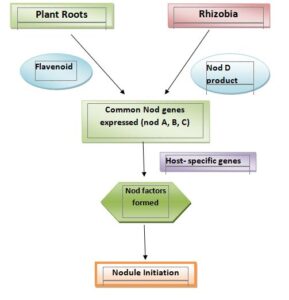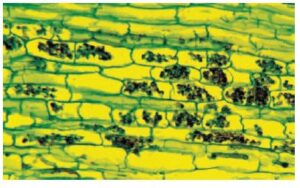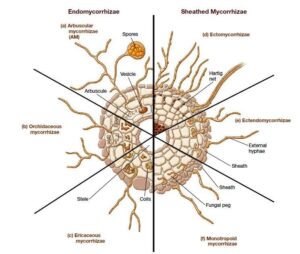Introduction
- Plant-Microbe is closely associated with each other, both surfaces of roots and shoots provide micro-habitats for microbial growth.
- Soil microbes are heterotrophic in nature, for primary production they evolved to form close relationships with plants.
- It’s been observed many plants-microbes interaction is not detrimental to plants usually these microbes are commensal, which means one partner is benefitted other remains unaffected neither benefitted nor harmed.
- Other microbes are mutually associated with plants [Both host plant and microbes are benefitted from the association].
- Other microbes are parasitic in nature, and it’s harmful to the plant.
Terminology
- Rhizosphere, the term was coined by Larenz Hiltner in 1904, means “the area of soil around roots of the plant characterized with high microbial activity.”
- Rhizoplane, Micro-habitat of the surface of the roots.
- Endophytes– Microorganisms that inhabit the internal plant tissues.
- Phyllosphere– Micro-habitat or Environment of the aerial plant’s portion such as leaves.
- Epiphytes– Microorganisms that live on the plant’s surface.
- Phytosphere– It’s a collective term used for rhizosphere and phyllosphere.

How do microorganisms communicate with the host plants?
- Plants produce chemical signals molecules that are detected and responded to, by the microbes.
- In response to the chemical signal, microbes release compounds that are recognized by the plants.
- Chemotaxis, the movement of the microbes towards chemical signal produced by the plants, is initiated, later association of microbes with plants is established, which is thoroughly monitored by each other and accordingly adjust their activities
Microorganisms associated with different micro-habitats of plants
Phyllosphere Microorganisms
- As mentioned above, the environment of the aerial portion of the plant is termed as phyllosphere.
- It is considered to be hostile to support microbial growth, as leaves and stems go through humid changes, UV exposure, and temperature, as consequence there is fluctuation in the leaching of organic material such as simple sugars, which can easily support microbial growth.
- The diversity of microorganisms present in the phyllosphere includes bacteria, yeast, filamentous fungi, and heterotrophic and photosynthetic protists.
- Some proteobacteria such as Pseudomonas syringae and Erwinia, and Pantoea are also found.
- Some bacterial species such as Sphingomonas adapted well to protect themselves against high levels of UV radiation on plant surfaces, they produce the pigment that functions as a sunscreen.
Rhizosphere Microorganisms
- The microbial population is abundant in the rhizosphere area, it influences the growth of the host plants.
- Rhizosphere effect- The root plant exerts a direct influence on the soil bacteria within the rhizosphere, which is called the rhizosphere effect.
- The plant roots interact with the rhizosphere microorganisms based on the change in the soil chemical environment like the release of the organic chemicals in the soil by plant root, production of the plant growth factors, and mineral nutrients by rhizosphere microorganisms.
- Mutualistic association between roots and rhizosphere microorganisms is beneficial for each other, such as microorganisms obtain required growth factors for e.g., sugars, vitamins, and amino acids from the roots, whereas microbial community present in the rhizosphere benefits the plants.
- Removal of H2S which is toxic for the plants.
- Increase solubilization of mineral nutrients.
- Synthesis of essential nutrients such as vitamins and amino acids and plant growth factors.
- Protection against pathogens by antagonizing potential through competition.
- Substrates released from plant roots are classified by Rovio: Exudates, secretions, lysates, plant mucilages, and mucigel.
- Predominant genera are Pseudomonas and Achromabacter; which are plant growth-promoting rhizobacteria.
- Associative nitrogen fixation is carried out by nitrogen-fixing bacteria present on the plant roots, such as Azotobacter, Acetobacter, and Azospirillum.
- Symbiotic nitrogen fixers, categorized as follows:
- Rhizobium (Bacteria) – Legumes
- Frankia ( Actinomycete)- Nonlegume
- Anabaena( Cyanobacteria)- Azolla ( Fern)
- Rhizobium, are generally gram-negative heterotrophic bacteria that interact with roots of the legumes and form root nodules.
- The genus Rhizobium is divided into six genera as follows:
- Rhizobium : R. leguminosarum, R. loti
- Sinorhizobium: S. melioti, S. fredii
- Bradyrhizobium: B. japonicum, B.elkani
- Azorhizobium: A. caulinodans
- Allorhizobium
- Mesorhizobium
- These interactions are highly specific and involve genetic combinations such as nod genes.

Mycorrhizae
- Mycorrhizae (“fungus root”) are mutual associations between most plants and a limited number of the fungal species, coevolved, and depend on the activities of each other.
- Fungal species colonize the roots of 80 % of higher plants as well as mosses and ferns, these fungal species are not saprophytic in nature, which means, not obtaining carbohydrates by decomposing the organic matters instead they use carbohydrates obtained photosynthetically by the host plants.
- In return, associated fungus enhances the nutrient uptake of the host plants.
Classification of the Mycorrhizae
- Mycorrhizae are broadly classified into two groups as follows:
- Endomycorrhizea– Fungi enters the root cells, also known as arbuscular mycorrhizae.
- Ectomycorrhizae– it remains extracellular, which forms hyphae around the roots.
Endo mycorrhizae
- The most common type of mycorrhizae.
- Found in association with many tropical plants, especially with crop plants.
- Mostly belong to the division Glomeromycota, can’t be cultured without the plant hosts.
- The fungus enters the root cells and forms fungal hyphae invaginating the plasma membranes called arbuscules, although it’s an endo mycorrhiza, it doesn’t breach the root cell membrane.
- Arbuscules are transient in nature, they last for almost two weeks, they are vigorous colonizers which means a 5 cm segment of the root can support the growth of the 8 species and single germinated spore hyphae can colonize the roots of the different unrelated plant species.
- Functions of endo mycorrhizae in the host cell and how it benefits them:
- Provide protection against drought, nematodes, and other pests.
- Enhance phosphorous and nitrogen uptake by the host root cells.

Ectomycorrhizae
- It is formed by both ascomycete and basidiomycete fungi.
- Colonizes in all the trees in cooler climates.
- Functions: Transfers essential nutrients, such as nitrogen and phosphorous
- Development: Fungal mycelium grows around the cells of the roots, it thickens and forms a sheath that covers the entire roots.
- Ectomycorrhizae produces signaling molecules, which results in limitations of root hairs growth, colonized roots with fungi appear blunt, hyphae of fungi extend itself into the soil which results in rhizomorphs formation.
- Hyphae of fungi penetrate between cortical cells of the roots, which forms meshwork of hyphae termed as Hartig net.
- Rhizomorphs uptake nutrients and pass to the Hartig net and then to the root cells, which means fungus increases the efficiency of the nutrients transfer and some sugars like mannitol produces by the plants which can’t be used by them is assimilated by the fungal symbiont.

- Other than this two mycorrhizae, others type of mycorrhizae also exists such as Orchidaceous, Ericaceous, Ectendomycorrhizae, Monotropoid mycorrhizae. Further details are mentioned in the table.
Mycorrhizal Associations
| Mycorrhizal Classifications | Fungi Involved | Plants Colonized | Fungal Function |
| Ectomycorrhizae | Basidiomycetes, Some ascomycetes | 90% of trees and woody plants in temperate regions | Nutrient (N and P) uptake and transfer |
| Endomycorrhizea or Arbuscular | Glomeromycetes | Wild and crop plants, tropical trees | Nutrient (N and P) uptake and transfer, Facilitate soil aggregation, Promote seed production, Reduce pest and nematode infection, Increase drought and disease resistance |
| Ericaceous | Ascomycetes, Basidiomycetes | Low evergreen shrubs, | Mineralization of organic matter |
| Orchidaceous | Basidiomycetes | Orchids | Provides organic carbon and nutrients |
| Ectendomycorrhizae | Ascomycetes | Conifers | Nutrient uptake and mineralization of organic matter |
| Monotropoid mycorrhizae | Ascomycetes, Basidiomycetes | Flowering plants that lack chlorophyll (Monotropaceae; e.g., Indian pipe) | Nutrient uptake and transfer |

Reference and Sources
- https://www.researchgate.net/publication/309416545_Plant_Microbe_Interaction_in_Rhizosphere
- https://www.slideshare.net/alizayshehzad/microbial-ecology-of-soil
- https://www.uoanbar.edu.iq/eStoreImages/Bank/1098.pdf
- https://gcwgandhinagar.com/econtent/document/1587179065unit4.1biolo.nitrio.fixation.pdf
- https://www.sciencedirect.com/science/article/pii/S0034666711001862
